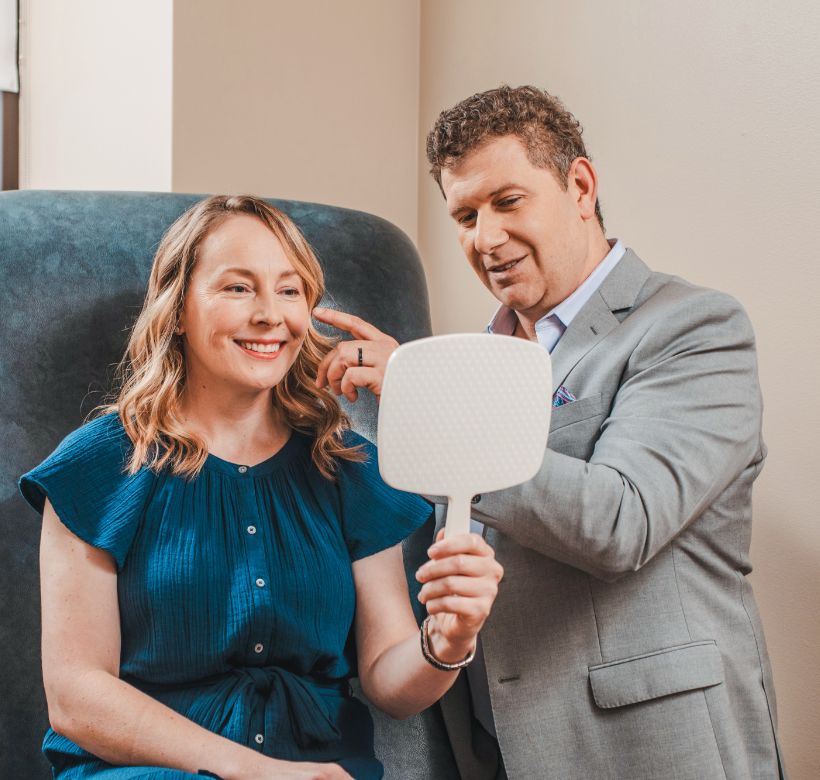Eyelid Surgery (Blepharoplasty)
What Is A Blepharoplasty?
Eyelid surgery, also known as a “blepharoplasty,” is a procedure that rejuvenates the appearance of the upper and / or lower eyelids. During a blepharoplasty procedure, loose, saggy skin (dermatochalasis) that causes fine lines and wrinkles is removed, and underlying fat deposits that cause puffiness and bags may be removed and / or repositioned. Removing the excess eyelid skin and addressing the underlying fat deposits, if present, results in a refreshed and well-rested appearance.
Get In Touch
The Benefits of A Blepharoplasty
Look More Youthful
Eyelid skin is the thinnest on the body. Because of this, the eyes often demonstrate the earliest signs of facial aging, typically in the form of fine lines, wrinkles, volume loss and excess, sagging skin. Blepharoplasty removes excess skin and tightens loose tissue surrounding the eyes to produce firm, smooth skin with a more youthful appearance.
Brighten Tired Eyes
Loose skin and fat deposits around the eyes can weigh down the eyelids and create a tired appearance even if a person is well rested. Excess fatty deposits can also create bags and puffiness around the eyes that contribute to a tired, swollen look. Eyelid surgery eliminates excess skin and fat to rejuvenate the areas around the eyes and provide patients with a more rested and alert appearance without giving a surprised look.
Restore Impaired Vision
Excess, sagging skin of the upper eyelids can hang down and impair a person’s full range of vision. The excess skin may even come to rest on the upper eyelashes in extreme cases (hooding). Upper eyelid surgery removes this excess skin so patients no longer have drooping eyelids impairing their vision.
How do I know when I’m ready for a blepharoplasty?
Ideal upper blepharoplasty candidates often demonstrate some or all of the following features:
- Excess, crepey upper eyelid skin
- Loss of upper eyelid crease definition
- Appearing tired even when well rested or appearing older than one’s actual age
Ideal lower blepharoplasty candidates often demonstrate some or all of the following features:
- Excess, crepey lower eyelid skin
- Bags of the lower eyelid
- Loss of a smooth transition between the lower eyelids and cheeks
- Appearing tired even when well rested or appearing older than one’s actual age
How Are Blepharoplasty And Brow Lifting Related?
The upper eyelid cannot be discussed without consideration of the brow (forehead). The upper eyelid skin seamlessly blends into the brow skin just below the eyebrows, and any ptosis (drooping) of the brow may affect the appearance of the upper eyelid. Often what patients see as excess skin of the upper eyelid may actually be a result of aging changes in the brow, which is why these areas must be examined together in order to develop an individualized surgical plan that may include a brow lift at the time of blepharoplasty.
Q. Will a lower blepharoplasty improve the dark circles under my eyes?
A. Possibly. Most patients with dark circles have increased pigmentation that is genetically inherited and won’t be improved by a lower blepharoplasty. There are patients, however, who have very prominent lower eyelid bags that are the result of underlying fat. These bags may cast a shadow on the lower eyelid skin and create the illusion of dark circles. These patients may note a significant improvement in this illusion following a lower blepharoplasty procedure.
Q. Where are the incisions placed for a blepharoplasty?
A. The incision for upper eyelid surgery is placed within the natural crease of the eyelid so that no scar will be noticeable once it heals. The incision for lower eyelid surgery may be inconspicuously placed just below the lashes to remove excess skin and address underlying fat deposits if present. Less frequently, an incision hidden inside the lower lid may be used to remove and / or reposition redundant tissue.
Q. When can I return to work and normal activities after the procedure?
A. Though it may vary depending on the specific operation you are recommended, most patients are able to resume work and normal activities roughly 5-7 days after upper eyelid surgery and 10-14 days after lower eyelid surgery. Some swelling and bruising may persist for a couple of weeks, and even months, particularly in lower eyelid surgery, but cold compresses will help reduce these side effects.
Q. How soon will I see the results of my eyelid surgery?
A. Results from blepharoplasty may be initially obscured due to swelling and bruising, but a rejuvenated, youthful eyelid contour will become visible within a few weeks after surgery. Incisions will initially be red, and possibly raised, however will continue to improve over time. It typically takes up to a year for incisions to fully flatten, fade and mature.
Q. Do all blepharoplasties require a brow lift?
A. No. These areas must, however, be examined together. While a blepharoplasty is often done without doing a brow lift, if there is descent of the brow, a combined procedure may be recommended.
Q. I’ve heard that eyelid surgery can be done in the office without anesthesia. Is this true?
A. An upper eyelid blepharoplasty, with or without a limited browlift, can often be performed in the office with local anesthesia only. Because of the increased complexities of lower eyelid surgery, lower eyelid blepharoplasties always require sedation or general anesthesia.
